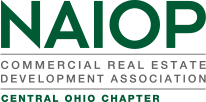Details
May 20, 2009
NAIOP May CE Program, 2pm - 5pm
Presented by Capital Crossroads SID
Downtown Walking Tour
We have be APPROVED for 1.5 CE hours for this program. You must attend the entire program to receive CE credit.Locations:
175 S. Third Street, 10th floor, Registration (2pm to 2:30pm) and Presentation (2:30pm to 3pm)
21 E. State Street, 10th Floor, Presentation (3:15 pm to 3:45pm)
Ohio Theatre, 55 E. State Street, Presentation (4pm to 4:30pm) and Reception follows
For secured online registration, REGISTER TODAY!
Program outline:
Columbus City Center and RiverSouth
CDDC Vice President Amy Taylor
Buildings are going up and buildings are coming down. Get an update on what's going up in RiverSouth and what's going down at City Center. What is the plan for Columbus City Center? How long will the transformation take? Why is the current plan more likely to succeed than the mall it replaces?
Review of construction in RiverSouth
Plans for Columbus City Center
Timeline
Process for redevelopment
Downtown's role in sustaining the environment
Executive Director of Mid-Ohio Regional Planning Commission Chester Jourdan
Professor, Associate Dean for Graduate and ProfessionalEducation, City & Regional Planning Section, OSU Hazel Morrow-Jones
Director of Neighborhood Development for United Way of Columbus Michael Wilkos
The former Lazarus Department Store is the most significant "green" rehabilitation project in the country. Downtown's central location and density are equally important, reducing its "carbon footprint" and making it environmentally sustainable as well as "green". Learn downtown's environmental selling points, including the following:
The impact of commuting
The role of density in a sustainable environment
How the location of jobs can create a sustainable city
Dressing up downtown
MSI principle Keith Myers
Capital Crossroads Executive Director Cleve Ricksecker
Throughout the United States, the downtown private sector in many cities is assuming a larger role in managing the public realm. In many downtown areas, the private sector is managing construction of public improvements, including sign systems, parks, streets, public art, landscaping of rights of way, and other capital projects. Columbus is no exception. This session will explore the following:
The relationship between the public and private sectors in downtown Columbus
Executed projects
Future projects in conceptual stages



